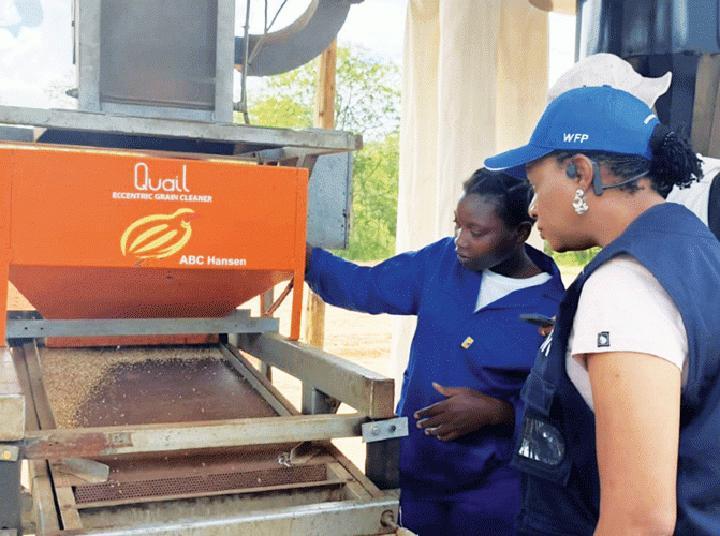Africa-Press – Zimbabwe. PHILLIP Mapfumo and his wife Kestina Sibanda, from Mwenezi’s ward 7, are forever grateful for coming across information that led them to venture into Sesame farming after a bumper harvest on their first trial.
Sesame is a highly sought-after crop, particularly in the Asian markets.
For the couple, the task of growing it is quite easy and cheap but with lucrative returns.
“Last season was our first attempt to plant Sesame seeds,” Mapfumo said.
“We were just ordinary villagers trying to make ends meet and venturing into large-scale farming was only a dream, considering the inputs needed, which require a lot of money to secure.
“We decided to give Sesame farming a try after we heard about the programme where farmers are trained and assisted with inputs as well as marketing the product, which is exported to countries like Japan.”
He said the first harvest, despite the El Niño-induced drought last season, was something they never anticipated.
What was more surprising for them was the income they got.
“We managed to harvest two and half tonnes which we sold to the nearby sesame plant, which serves as an intermediary between farmers and the markets outside the country. We had an unfinished house, which we managed to extend and finish,” Mapfumo said.
“We also bought land at the local business centre and started building our shop, which is almost complete. It is our hope that we do it with proceeds from this season and get our retail business running.”
He added: “It is also our hope that with more financial gains, we buy equipment for large-scale farming of the crop.
“At the moment, we are relying on cattle for farming, which is not viable, particularly during the onset of the season when they will be weak and fragile without proper feeding.”
According to Mapfumo, the crop, which thrives under such conditions, is the easiest and cheapest to grow given that they receive minimal rainfall.
“This season, we grew our crop on a much bigger size than last time. We did so with the first rains but that did not stop progress when they stopped for a long time,” he said.
“Our crop grew regardless of that. By the time the rains fell again, we were weeding our fields. We had challenges with pests, but we used natural remedies to ward them off.
“We used paw paw leaves and tobacco stalk remnants put in water and left to set overnight. We never used any chemical-based pesticides on our crop, which is why we say it is easier and cheaper to grow.”
Sibanda echoed similar sentiments saying use of available resources and herbs has enabled them to ensure that their crop is healthy and free from pests at a very minimal cost.
“We really need to have machinery for farming so that we manage to grow our crop earlier, dodging the challenges that come with using draught power.
“We also want to increase the farming area so that we increase the outcome,” she said.
“The money we realised from our first trial was a game changer and we are grateful for those who came in to assist us.
“We managed to achieve more than we anticipated with the money we got from selling our produce to the nearby sesame plant.”
Mapfumo and Sibanda are part of an out grower programme, where they grow the crop with assistance from a partnership involving the Japanese embassy, Sustainable Agriculture Technology (SAT) and the World Food Programme (WFP).
The farmers, from Mwenezi and surrounding areas, have received technical assistance and market access to produce high-quality Sesame for Japanese buyers.
Lloyd Masunda, the deputy country director for SAT, said out of the
6 600 hectares of land under the programme, they hope to achieve at least 3 320 tonnes of sesame this
season.
“That’s a significant increase from where we were last season. We hope to be able to aggregate a significant portion of what we are going to produce,” he said.
“But we are aware that there are other players on the market, including those who smuggle sesame illegally through our borders and that may affect our projections.”
Masunda said they had fine-tuned their operations and dealt with possible cash challenges.
“We have innovated and we have a partner called Mutual and we are going to be disbursing funds to farmers through an innovative mobile money wallet that has less transaction costs to the farmer and that will help us to buy from multiple points at the same time,” he said.
“Last season, we were buying only in one location at a time, but this season it will be multi-faceted. We are also going to be upping our game through the generous funding support from our funding partners.”
Japanese embassy consular Masataka Nakamura said his is highly committed to assist in Zimbabwe’s agricultural endeavours.
“Japan recognises the potential of Zimbabwean farmers, and we are pleased to support them in expanding sesame production for export,” Nakamura said.
“This partnership is not only about trade, but also about sharing knowledge and enhancing food security.”
Said World Food Programme (WFP) Masvingo Field Office programme policy officer Munyaradzi Gahadzikwa: “Mapfumo is one of the 3 500 farmers that we have supported here in Mwenezi with funding support from the Government of Japan and also working collaboratively with the SAT and the relevant government line ministries where we witness the production of sesame value chain and we are happy to realise this level of production here in Mwenezi district which is one of the drought-prone districts and is usually affected by drought and erratic rainfall.
“We are happy that one of the farmers that was supported is looking forward to a good harvest, better harvest despite the challenges that they faced from the climatic shocks that have impacted them.”
Gahadzikwa said the 3 500 farmers they support are the most vulnerable and food insecure people finding it difficult to put food on their tables to feed their families.
“With this kind of support they will be able to achieve food security, nutrition security and income security,” he said.
The programme is premised on a US$5 million funding grant from WFP and Japan.
For More News And Analysis About Zimbabwe Follow Africa-Press






